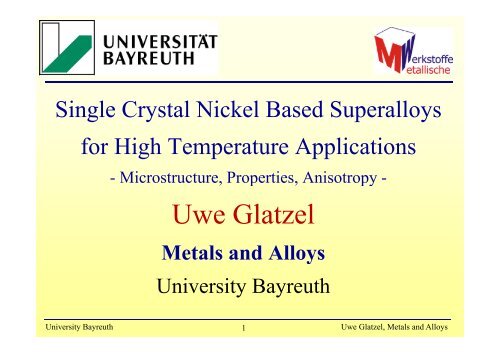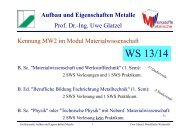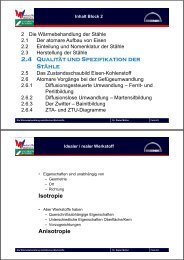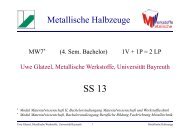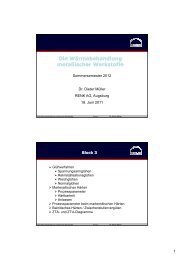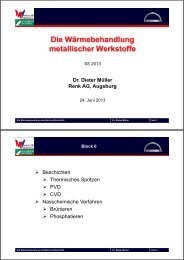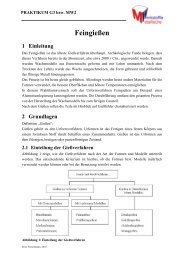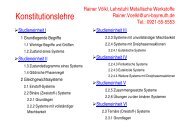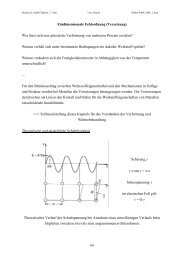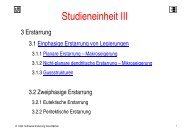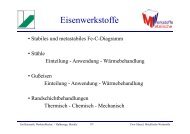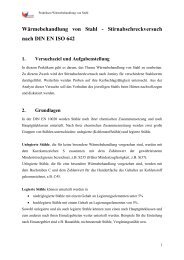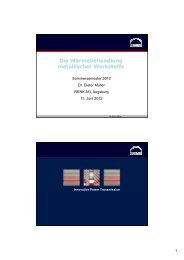Uwe Glatzel
Uwe Glatzel
Uwe Glatzel
Create successful ePaper yourself
Turn your PDF publications into a flip-book with our unique Google optimized e-Paper software.
Single Crystal Nickel Based Superalloys<br />
for High Temperature Applications<br />
- Microstructure Microstructure, Properties Properties, Anisotropy -<br />
<strong>Uwe</strong> <strong>Glatzel</strong><br />
Metals and Alloys<br />
University yBayreuth y<br />
University Bayreuth <strong>Uwe</strong> <strong>Glatzel</strong>, Metals and Alloys<br />
1
Content<br />
• motivation: history, application field<br />
• processing<br />
• microstructure, misfit<br />
• anisotropic properties<br />
(modulos (modulos, creep behavior)<br />
• dislocations, stress induced diffusion<br />
• Outlook: alloys with reduced density, platinum<br />
based superalloys<br />
University Bayreuth <strong>Uwe</strong> <strong>Glatzel</strong>, Metals and Alloys<br />
2
Superalloys for Extreme<br />
DDemands d<br />
Single crystal nickel based superalloys as material for first<br />
rotating blades after the<br />
combustion chamber in aircraft flight g engines. g<br />
fan<br />
(thrust)<br />
compressor (titanium)<br />
gas temp.: 1500°C<br />
material: 1100°C<br />
20 20.000 000 rpm<br />
⇒ const. stress of<br />
about 100 MPa<br />
(≈ 1 car/cm2 )<br />
University Bayreuth <strong>Uwe</strong> <strong>Glatzel</strong>, Metals and Alloys<br />
3
Model<br />
JetCat P120SX<br />
Flight Model<br />
Rolls Royce RR300<br />
Helicopter<br />
Engine g Alliance<br />
GP 7270<br />
Airbus A380<br />
Examples Turbine Engines<br />
engine g<br />
weight<br />
[kg]<br />
engine power<br />
[kW]<br />
22<br />
14 1.4<br />
(push: 0.13 kN)<br />
disc revolution max. (!) ()<br />
diameter<br />
[m]<br />
speed<br />
[1/min.]<br />
consumption<br />
[l/h]<br />
cost<br />
[1,000 €]<br />
007 0.07 123 123,000 000 ~ 23 28 2.8<br />
80 225 ~ 0.24 50,000 ~ 80 ?<br />
BMW R6 (N52) 161 190 - - 6,000 ~ 65 ~ 6<br />
stationary gas turbine<br />
SGT5-8000H,<br />
Irsching close Munich,<br />
efficiency > 40%<br />
combined cycle > 60%<br />
6,700<br />
444,000<br />
60 60,000 000 take k off ff ~ 18 18,000 000<br />
~ 1.00 12,000<br />
(push: 370 kN)<br />
cruise ~ 3,600<br />
375,000<br />
(c.c.: 570 MW)<br />
~ 4.00 3,000<br />
~ 85,000 heavy<br />
fuel oil<br />
(~ 100,000 m3 /h<br />
gas)<br />
~ 13,000<br />
~ 200,000<br />
University Bayreuth <strong>Uwe</strong> <strong>Glatzel</strong>, Metals and Alloys<br />
4
adius r<br />
[m]<br />
Stress σ at the Foot of the Blade<br />
rotational blade stress<br />
2<br />
speed ω h A<br />
cyc length h σ Fz m⋅ω<br />
⋅ r ρ ⋅h<br />
⋅ A<br />
σ = = =<br />
[1/s] [m] [MPa] A A A<br />
0.035 2,050 0.01 464<br />
2<br />
⋅ω<br />
⋅ r<br />
2 ( ) 2<br />
= ρ ⋅ h⋅ ω ⋅ r = ρ ⋅ h⋅<br />
ω ⋅ ⋅ r<br />
~ 0.12 833 0.03 790 cyc 2π<br />
0.12 833 0.03 790<br />
~ 050 0.50 200 008 0.08 505<br />
ρ≈8 g/cm 3 … material density<br />
F z … centrifugal force<br />
A … area of blade foot<br />
~ 2.00 50 0.25 394 ω … angular speed<br />
maximum, short time stresses!<br />
University Bayreuth <strong>Uwe</strong> <strong>Glatzel</strong>, Metals and Alloys<br />
5
Blade for<br />
stationary<br />
gas turbine bi<br />
for power<br />
production<br />
≈ $ 40 40.000<br />
000<br />
Big Big, Single Crystal Blade<br />
University Bayreuth <strong>Uwe</strong> <strong>Glatzel</strong>, Metals and Alloys<br />
6
η =<br />
max<br />
theor. h<br />
Coefficient of Efficiency<br />
T<br />
regular fuel car engine: < 37%<br />
car diesel engine: < 43%<br />
ship hi di diesel l engine i ( (up tto 900/ 900/min.): i ) < 50%<br />
aircraft turbine: < 40%<br />
stationary gasturbine: < 42%<br />
gas and steam generation: < 60%<br />
Irsching (gas and steam generation): ~ 60%<br />
(gas (g + steam + longg distance heating:~ g 87%) )<br />
max<br />
− T<br />
T<br />
min<br />
min<br />
increase of Tmax increases<br />
coefficient of efficiency<br />
University Bayreuth <strong>Uwe</strong> <strong>Glatzel</strong>, Metals and Alloys<br />
7
[°C]<br />
tempperature<br />
2000<br />
1500<br />
1000<br />
500<br />
Increase in Temperature due to<br />
Improved Construction and Material<br />
polycrystalline<br />
military<br />
civilian<br />
directional solidified<br />
single i l crystal t l<br />
gas temper perature<br />
material tempera perature<br />
improved cooling<br />
improved materials<br />
1950 1960 1970 1980 1990 2000<br />
year<br />
ceramics??<br />
platinum lti<br />
base alloys?<br />
constant<br />
improvement<br />
5-10°C/year<br />
University Bayreuth <strong>Uwe</strong> <strong>Glatzel</strong>, Metals and Alloys<br />
8
floww<br />
stresss<br />
[MPaa]<br />
500<br />
400<br />
Why nickel based superalloys?<br />
Anomalous flow stress behavior of the<br />
intermetallic phase Ni3Al: superalloy heat treated<br />
300 superalloy as cast<br />
200<br />
100<br />
Copley l and dKear,<br />
Trans. AIME<br />
Vol. 239 (1967), 984-992<br />
0<br />
Ni 3 Al<br />
nickel solid solution<br />
0 200 400 600 800 1000<br />
ttemperature t [°C]<br />
70 %<br />
100 %<br />
0 %<br />
University Bayreuth <strong>Uwe</strong> <strong>Glatzel</strong>, Metals and Alloys<br />
9
History yTurbine Engines g<br />
(very strong connected with materials history)<br />
Patents on stationary turbines: 1873 first patent application Franz<br />
Stolze, Berlin "Feuerturbine" (� denied). 1884 Britain first stem<br />
turbine patent granted. Stolze's 2 nd attempt 1897 succesful (same<br />
year in USA). First time running in 1904 with 400°C inlet<br />
temperature.<br />
Commercially<br />
successful<br />
~1930<br />
University Bayreuth <strong>Uwe</strong> <strong>Glatzel</strong>, Metals and Alloys<br />
10
History y Flight g Engines g<br />
(very strong connected with materials history)<br />
• ~ 1930 development of turbine engines for airplanes airplanes.<br />
• 1939 first succesful flight with JUMO 004 on a Me 262 fighter.<br />
Milit Military was not t convinced i dof f bth both airplane i l andd engine. i Bi Big<br />
problems with life time of turbine blades (only ~ 10 h).<br />
First material: TINIDUR Fe Ni30 Cr14 Cr14, then switched to<br />
CROMADUR Fe Cr12 Mn 18 (due to Ni shortage)<br />
JUMO 004<br />
Me 262 replica<br />
University Bayreuth <strong>Uwe</strong> <strong>Glatzel</strong>, Metals and Alloys<br />
11
Recent History Materials<br />
≈ 1980: Inconel 738 (polycrystalline) => 738 LC (single crystal)<br />
50-60vol.% γ' phase, 3wt.% W, 0% Re<br />
SRR 99, CMSX-6 (first generation single crystal)<br />
60-70% γ', 9% W, 0% Re<br />
≈ 1990 1990: CMSX CMSX-4 4( (secondd generation ti SX)<br />
> 70 % γ', 6% W, 3% Re<br />
≈ 1995: CMSX-10 CMSX 10 (third generation SX)<br />
> 70 % γ', 6% W, 6% Re<br />
Costly and time intensive heat treatment:<br />
3-stage homogenization, controlled rapid cooling<br />
2-stage aging<br />
University Bayreuth <strong>Uwe</strong> <strong>Glatzel</strong>, Metals and Alloys<br />
12
Content<br />
• motivation: history, application field<br />
• processing<br />
• microstructure, misfit<br />
• anisotropic properties<br />
(modulos (modulos, creep behavior)<br />
• dislocations, stress induced diffusion<br />
• Outlook (alloys with reduced density, platinum based<br />
superalloys) p y )<br />
University Bayreuth <strong>Uwe</strong> <strong>Glatzel</strong>, Metals and Alloys<br />
13
R = ΔT/Δx<br />
Single Crystal Growing<br />
v = Δx/Δt<br />
alternative: seeding technique<br />
[001]<br />
crystal<br />
direction<br />
R⋅v = ΔT/Δt /<br />
determines the dendrite<br />
spacing i<br />
University Bayreuth <strong>Uwe</strong> <strong>Glatzel</strong>, Metals and Alloys<br />
14
Heat Treatment<br />
example: CMSX-4 standard heat treatment<br />
homogenization:<br />
1h@1280°C 1 h @ 1280 C, 2 h @ 1290 1290°CC, 6 h @ 1300 1300°CC<br />
cooling rate 150-400°C/min.<br />
aging<br />
6 h @ 1140 1140°CC für 6 h, 870 870°CC für 16 h<br />
if possible, possible combined with coating treatment<br />
University Bayreuth <strong>Uwe</strong> <strong>Glatzel</strong>, Metals and Alloys<br />
15
Content<br />
• motivation: history, application field<br />
• processing<br />
• microstructure, misfit<br />
• anisotropic properties<br />
(modulos (modulos, creep behavior)<br />
• dislocations, stress induced diffusion<br />
• Outlook (alloys with reduced density, platinum based<br />
superalloys) p y )<br />
University Bayreuth <strong>Uwe</strong> <strong>Glatzel</strong>, Metals and Alloys<br />
16
Microstructure<br />
ttwo-phase, h single i l crystal: t l<br />
face face-centred-cubic<br />
centred cubic<br />
matrix<br />
(nickel solid solution)<br />
Ni 3Al => fcc, but superlattice<br />
ordering, d i L1 2 or γ' 'Ph Phase di dislocation l ti free<br />
f<br />
University Bayreuth <strong>Uwe</strong> <strong>Glatzel</strong>, Metals and Alloys<br />
17
Ni Ni3Al 3Al ⇔ nickel solid solution<br />
nickel atoms in face centre<br />
aluminium atoms on<br />
cube corners<br />
d Ni3Al = 358,0 pm d nickel solid sol. = 358,7 pm<br />
in nickel solid solution � statistical distribution of atoms<br />
University Bayreuth <strong>Uwe</strong> <strong>Glatzel</strong>, Metals and Alloys<br />
18
Optimal Precipitation Hardening<br />
• round dparticles i l<br />
(better than needle-shaped)<br />
• hi high h volume l fraction f i<br />
• finely dispersed<br />
• small ll particles ti l ( )<br />
• hard precipitates,<br />
soft ft matrix t i<br />
in text books no<br />
information given on<br />
optimum misfit<br />
500 nm<br />
University Bayreuth <strong>Uwe</strong> <strong>Glatzel</strong>, Metals and Alloys<br />
19
Constrained ↔ Unconstrained<br />
Misfit<br />
Small difference in lattice parameter, Δd/d ≈ - (1 – 3)·10 -3<br />
resulting in a coherent interface and internal stresses:<br />
Matrix<br />
isotropic misfit<br />
γ' Phase<br />
Δ d<br />
σ = E ≈100<br />
− 300 MPa<br />
d<br />
Matrix<br />
γ' Phase<br />
misfit high dependent compression stresses of planes in<br />
taken k matrix for f parallel Bragg B to reflection<br />
interface<br />
fl i<br />
University Bayreuth <strong>Uwe</strong> <strong>Glatzel</strong>, Metals and Alloys<br />
20
Two-Phase but 100% Coherent<br />
=> Internal Stresses<br />
University Bayreuth <strong>Uwe</strong> <strong>Glatzel</strong>, Metals and Alloys<br />
21
Stress Distribution<br />
stress<br />
σxx [MPa]<br />
two views of 1/8 of the γ' γ cube with surrounding g<br />
matrix<br />
University Bayreuth <strong>Uwe</strong> <strong>Glatzel</strong>, Metals and Alloys<br />
22
in γ' phase<br />
compression<br />
tension<br />
Stress Distribution<br />
Schematical<br />
in matrix<br />
University Bayreuth <strong>Uwe</strong> <strong>Glatzel</strong>, Metals and Alloys<br />
23
ddendrite d i spacing i<br />
≈ 1/4 mm<br />
single crystal,<br />
bt but no hgomogeneous<br />
h<br />
distribution of tungsten<br />
and rhenium<br />
"Macrostructure"<br />
Macrostructure<br />
[010]<br />
[001]<br />
⇒ therefore local variation of misfit<br />
University Bayreuth <strong>Uwe</strong> <strong>Glatzel</strong>, Metals and Alloys<br />
24
Variation of Misfit due to<br />
Dendritic Segregation<br />
[10 -3 ]<br />
• negative misfit in dendrite<br />
• close to zero in interdendritic region<br />
Völkl, <strong>Glatzel</strong>, Feller-Kniepmeier; Acta mat. 46 (1998) 4395<br />
1<br />
0<br />
-1<br />
-22<br />
-3<br />
-4<br />
-5<br />
Fehlpassung gemessen mit CBED<br />
Neutronenstreuung<br />
Interdendrit Dendrit Interdendrit<br />
University Bayreuth <strong>Uwe</strong> <strong>Glatzel</strong>, Metals and Alloys<br />
25
interdendritic region<br />
Spannnung<br />
[MPPa]<br />
-50<br />
-100<br />
-150<br />
-200<br />
-250<br />
-300 300<br />
Local Stress Variation<br />
dendrite<br />
200 400 600 800<br />
-2.5<br />
-5<br />
-7.5<br />
-10 10<br />
-12.5<br />
up to 300 MPa compression stress<br />
-15<br />
iin matrix t i channels h l in i dendrite d d it<br />
-17.5<br />
spacing i ≈ 250 μm<br />
5 10 15 20<br />
spacing ≈ 0,5 μm<br />
University Bayreuth <strong>Uwe</strong> <strong>Glatzel</strong>, Metals and Alloys<br />
26
Content<br />
• motivation: history, application field<br />
• processing<br />
• microstructure, misfit<br />
• anisotropic properties<br />
(modulos (modulos, creep behavior)<br />
• dislocations, stress induced diffusion<br />
• Outlook (alloys with reduced density, platinum based<br />
superalloys) p y )<br />
University Bayreuth <strong>Uwe</strong> <strong>Glatzel</strong>, Metals and Alloys<br />
27
Elastic Anisotropy together<br />
with ihMi Misfit: fi<br />
�� Explanation for cuboidal γ' precipitates,<br />
with {100} phase boundary planes<br />
�� thereby very high volume fractions<br />
achievable<br />
University Bayreuth <strong>Uwe</strong> <strong>Glatzel</strong>, Metals and Alloys<br />
28
00> [GPa]<br />
E
Creep Deformation<br />
University Bayreuth <strong>Uwe</strong> <strong>Glatzel</strong>, Metals and Alloys<br />
30
High Temperature<br />
Deformation up to 1400°C<br />
temperature<br />
and load are<br />
kept ept co constant sta t<br />
University Bayreuth <strong>Uwe</strong> <strong>Glatzel</strong>, Metals and Alloys<br />
31
l 0<br />
Orientation Dependence<br />
Single crystal with load axis<br />
parallel to [001]<br />
constant load of 500 MPa<br />
(T = 850°C)<br />
"horizontal" / "vertical"<br />
matrix channels<br />
at 850°C<br />
10-6<br />
Strrain<br />
Rate [11/s]<br />
10 -7<br />
10 -8<br />
→ [001] orientation shows best<br />
creep performance<br />
A 2<br />
A 1<br />
C 1<br />
B 2<br />
B 1<br />
+<br />
+<br />
+Fracture<br />
M<br />
CMSX-4<br />
1123K, 500MPa<br />
0 1 2 3<br />
Strain [%]<br />
C1<br />
University Bayreuth 32<br />
<strong>Uwe</strong> <strong>Glatzel</strong>, Metals and Alloys<br />
[111]<br />
M<br />
A 2<br />
B2 B 2<br />
A 1<br />
[001] B 1 [011]
te [s ] -1 strain<br />
rat ]<br />
Orientation Dependence<br />
C<br />
at 980°C<br />
A A<br />
strain<br />
C<br />
anisotropy has less<br />
influence at higher<br />
temperatures<br />
University Bayreuth <strong>Uwe</strong> <strong>Glatzel</strong>, Metals and Alloys<br />
33
Changes in Morphology<br />
980°C, 350 MPa, 28 h<br />
[100]<br />
rafts with planes normal to the<br />
external [001] load axis<br />
σ σ<br />
[001] [110]<br />
[010]<br />
[100]<br />
bars with long axis<br />
parallel to <br />
University Bayreuth <strong>Uwe</strong> <strong>Glatzel</strong>, Metals and Alloys<br />
34<br />
[110]
[001] crystal orientation:<br />
• fastest growing direction +<br />
• elastic soft is good for thermal fatigue +<br />
• elastic soft and misfit leads to {001} phase<br />
boundaries (� cuboidal γ' particles) +<br />
• direction of best creep properties +<br />
University Bayreuth <strong>Uwe</strong> <strong>Glatzel</strong>, Metals and Alloys<br />
35
Content<br />
• motivation: history, application field<br />
• processing<br />
• microstructure, misfit<br />
• anisotropic properties<br />
(modulos (modulos, creep behavior)<br />
• dislocations, stress induced diffusion<br />
• Outlook (alloys with reduced density, platinum based<br />
superalloys) p y )<br />
University Bayreuth <strong>Uwe</strong> <strong>Glatzel</strong>, Metals and Alloys<br />
36
Dislocation configuration<br />
during primary creep<br />
Ph.D. thesis<br />
Th. Link,<br />
TU-Berlin<br />
(1988)<br />
Movement of dislocations<br />
up to 0.5% plastic<br />
deformation mainly in<br />
matrix channels.<br />
University Bayreuth <strong>Uwe</strong> <strong>Glatzel</strong>, Metals and Alloys<br />
37
FEM calculation of stress<br />
di distribution ib i ( (pure elastic) l i )<br />
No external load<br />
� high g compression p stresses in<br />
matrix channels parallel to the<br />
phase boundaries<br />
σ<br />
compression<br />
tension<br />
With an external load (500 MPa)<br />
� high g stress levels in horizontal<br />
channels; low stress levels in<br />
vertical channels<br />
pure elastic at time t = 0<br />
University Bayreuth <strong>Uwe</strong> <strong>Glatzel</strong>, Metals and Alloys<br />
38
tension<br />
FEM calculations of stress distribution<br />
after creep p (plastic (p deformation) )<br />
(Matrix according to Norton creep, γ' phase yields plastisch)<br />
hydrostatic tension p ≈σ ext.<br />
dislocations networks:<br />
horizontaler channel:<br />
High density of edge<br />
dislocations with additional<br />
hlf half plane l within ihiγ' ' phase h<br />
σext. vertical channel:<br />
network of LH- and RH-<br />
screw dislocations,<br />
1/3 density<br />
University Bayreuth <strong>Uwe</strong> <strong>Glatzel</strong>, Metals and Alloys<br />
39
TEM Dislocation Structure:<br />
cross section, ti ε = 21% 2.1 %<br />
external load normal to view plane<br />
50 disl. per cube � ρ≈20⋅10 13 m -2<br />
look onto horizontal matrix<br />
channels, vertical channels edge-on.<br />
longitudinal section<br />
ε = 1 %<br />
10 disl. per cube � ρ ≈ 4⋅1013 m-2 p ρ<br />
University Bayreuth<br />
load axis<br />
40<br />
<strong>Uwe</strong> <strong>Glatzel</strong>, Metals and Alloys
Stress Induced Diffusion<br />
(EDX-TEM)<br />
Large atoms diffuse from vertical to<br />
horizontal channel.<br />
horizontal channel<br />
tungsten<br />
c = 1.<br />
2⋅<br />
σ ext ≈ 500 MPa<br />
ext.<br />
Schmidt and Feller-Kniepmeier, 1993 (SRR99, 760°C)<br />
c<br />
vertical channel<br />
tungsten<br />
University Bayreuth <strong>Uwe</strong> <strong>Glatzel</strong>, Metals and Alloys<br />
41
Summary: Different Strengthening<br />
MMechanisms h i in i Ni-Base Ni B SSuperalloys ll<br />
• It Internal lb back kstress: t σ i = α ⋅ G ⋅ b b⋅<br />
~ 250 MPa ≈ σexternal • Orowan stress:<br />
~ 500 MPa (reduced by coarsening)<br />
• Solid solution strengthening (e.g. by Re):<br />
~110MPa(short range ~1/r2 ~ 110 MPa (short range ~ 1/r )<br />
σ<br />
ρ<br />
Orowan<br />
σ<br />
G ⋅b<br />
≈<br />
L<br />
i<br />
solid solution<br />
• Coherent γ' precipitates: σ coherency ≈ δ ⋅ E<br />
~ -200 MPa (compression, reduced by semi-coherency)<br />
≈<br />
Ω − Ω<br />
Ω<br />
i ci With α =1, G = 100 GPa ≈ E, b = 250 pm, ρ = 1014 m-2 , , p , ρ , L = 50 nm, , c Re = 1 at.%, ,<br />
, δ = -2⋅10-3 Ω<br />
− ΩNi<br />
Re =<br />
Ω<br />
Ni<br />
0.<br />
11<br />
University Bayreuth <strong>Uwe</strong> <strong>Glatzel</strong>, Metals and Alloys<br />
42<br />
E
Summary:<br />
changes h occuring i ddurig i creep<br />
dislocation networks in<br />
phase boundaries<br />
(plastic deformation<br />
according to local<br />
stress distribution)<br />
=> stress induced<br />
diffusion<br />
FEM<br />
+<br />
TEM<br />
W Re Re W Re<br />
TEM<br />
+<br />
EDX<br />
γ'<br />
W<br />
Re<br />
γ'<br />
W<br />
σ ext<br />
TEM +<br />
FEM<br />
=> high hydrostatic stress<br />
level in horizontal channel<br />
+<br />
change in lattice<br />
parameter (misfit). γ'<br />
Change g and<br />
reduction of stress<br />
level.<br />
neutron diffr.<br />
additionally: compostion variation dendrite – interdendritic region<br />
and morphology changes<br />
University Bayreuth 43<br />
<strong>Uwe</strong> <strong>Glatzel</strong>, Metals and Alloys<br />
-
Content<br />
• motivation: history, application field<br />
• processing<br />
• microstructure, misfit<br />
• anisotropic properties<br />
(modulos (modulos, creep behavior)<br />
• dislocations, stress induced diffusion<br />
• Outlook (alloys with reduced density, platinum based<br />
superalloys)<br />
University Bayreuth <strong>Uwe</strong> <strong>Glatzel</strong>, Metals and Alloys<br />
44
Outlook<br />
• International patent (<strong>Glatzel</strong>, Mack, Wöllmer, Wortmann):<br />
Rd Reduce W and dR Re content t t�� reduced d dddensity, it improved i d<br />
phase stability, larger temperature window for solution heat<br />
ttreatment, t t cheaper h �� LEK 94. 94<br />
Within GP 7000 engine for Airbus A 380.<br />
• DFG-Project "Platinbasissuperlegierungen":<br />
Pt-Al-Cr-Ni (+ Ta, + Ti) alloys can copy successful system of nickel<br />
based superalloys (coherent L12 ordered, cuboidal γ' particles with<br />
hi high h volume l fraction f ti embedded b dd d in i fcc-matrix)<br />
f ti )<br />
University Bayreuth <strong>Uwe</strong> <strong>Glatzel</strong>, Metals and Alloys<br />
45
stress [MPa] [<br />
500<br />
230<br />
120<br />
24 K<br />
ΔT = 10 K<br />
LEK 94<br />
10 K<br />
CMSX-6 [Wortmann 88] 8.0 g/cm 3<br />
CMSX-4 [Erickson 94] 8.7 g/cm 3<br />
CMSX-4 [Frasier 90] 8.7 g/cm 3<br />
LEK-2 8.5 g/cm 3<br />
g<br />
LEK-4 8.2 g/cm 3<br />
LEK-5 8.2 g/cm 3<br />
LEK-3 8.1 g/cm 3<br />
LEK-6 83g/cm 3<br />
LEK-6 8.3 g/cm<br />
LEK-1C 8.4 g/cm 3<br />
LEK-1B 8.3 g/cm 3<br />
LEK-1A 8.2 g/cm 3<br />
29 K<br />
25 26 27 28 29 30 31 32<br />
Larsen-Miller-Parameter<br />
Larsen Miller Parameter<br />
P = (T+273) [20+log tB ] 10 -3<br />
not corrected with<br />
density! y<br />
Patente: D, Europa, USA, Kanada, Japan<br />
University Bayreuth <strong>Uwe</strong> <strong>Glatzel</strong>, Metals and Alloys<br />
46
PPt 77Al Al14Cr C 6Ni Ni6<br />
12h @1500°C +<br />
120h @1000°C<br />
CMSX-4,<br />
same<br />
magnification<br />
Microstructure<br />
Platinum Based Superalloy<br />
Hüller et al., Met.Mat.Trans. A, 36A (2005), 681<br />
University Bayreuth <strong>Uwe</strong> <strong>Glatzel</strong>, Metals and Alloys<br />
47
Misfit<br />
Platinum Based Superalloys<br />
Pt84Al 84 11Cr 11 3Ni 3 2<br />
Pt 80Al 11Cr 3Ni 6<br />
Pt 77Al 10Cr 3Ni 10<br />
University Bayreuth <strong>Uwe</strong> <strong>Glatzel</strong>, Metals and Alloys<br />
48
Stress<br />
1000<br />
100<br />
Creep Properties<br />
Platinum Based Superalloys<br />
CMSX-4 (single crystal !)<br />
Maximum Stress in<br />
Compression with<br />
-5 -1<br />
St Strain i Rate R t 10 5 s 1<br />
γ' precipitate dissolution<br />
in Ni-base alloys<br />
γ' precipitate dissolution<br />
in Pt-base alloys<br />
Pt82Al7Cr6+Ta5<br />
Pt82Al7C Pt82Al7Cr6+Ti5 6+Ti5<br />
Pt77Al12Cr6+Ni5<br />
Pt77Al12Cr6+Fe5<br />
Pt77Al12Cr6+Co5<br />
10<br />
700 800 900 1000 1100 1200 1300 1400<br />
Temperature [°C]<br />
University Bayreuth <strong>Uwe</strong> <strong>Glatzel</strong>, Metals and Alloys<br />
49
University Bayreuth <strong>Uwe</strong> <strong>Glatzel</strong>, Metals and Alloys<br />
50


